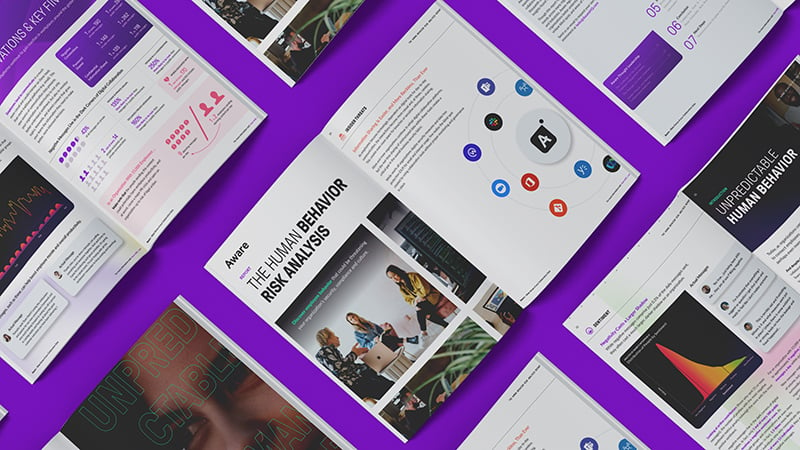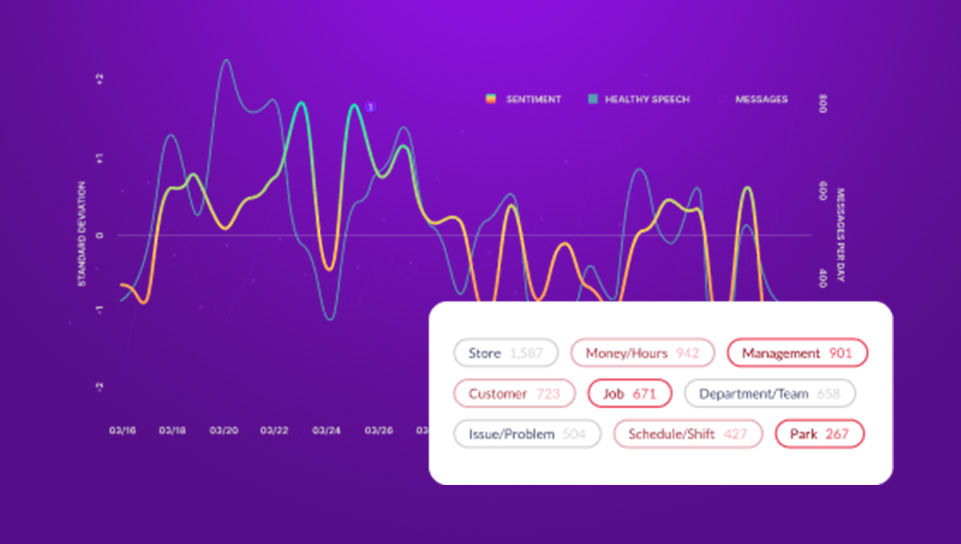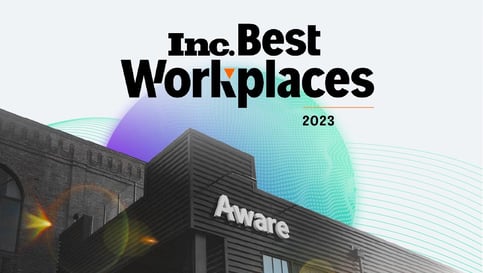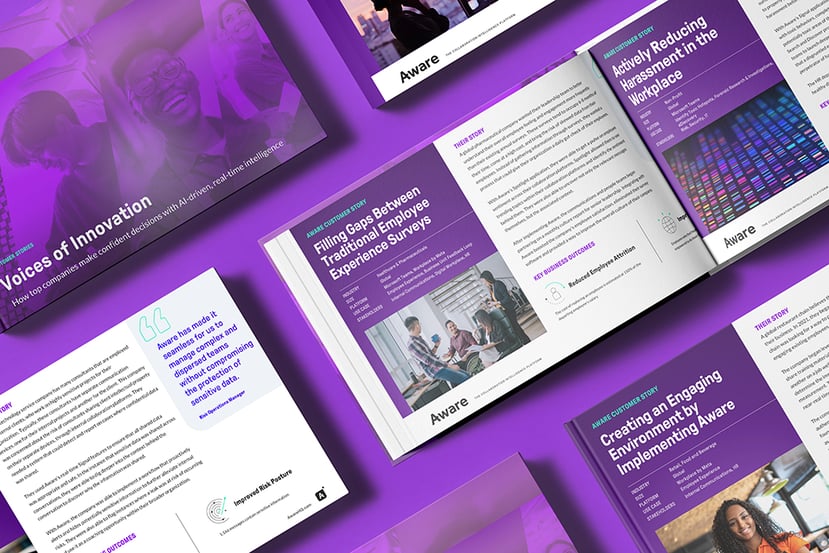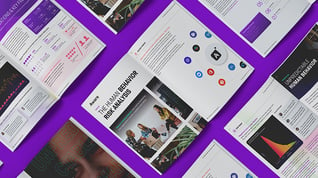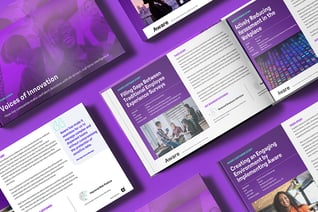What is the Voice of the Employee?
by Aware

First Published Sept. 2023. Updated Mar. 2024.
You people are talking. Is your organization listening? The Voice of the Employee is the collective feedback, opinions, and sentiment of your workforce. Employee voice can be formal, for example in survey results and focus groups, or informal, for instance in workplace collaboration apps or on social media.
By tapping into the voice of the employee, executives can harness this collective experience and intelligence to inform more insightful decision making from the top down. In this article, we'll explore the significance of the voice of the employee and provide a roadmap to build a robust employee listening strategy.
Contents
- Examples of employee voice
- Why is it important to track the voice of the employee?
- How do you capture the voice of the employee?
- Best practices to improve employee listening
- Examples of voice of the employee in action
- How Aware gathers the authentic voice of the employee
Examples of employee voice
What does the voice of your employees sound like? Often it depends on where executives are listening. It can be formal or informal depending on setting. Employees can choose to speak up and submit feedback, or employee insights can be gathered passively. A robust employee listening strategy seeks to gather the voice of the employee from as many places as possible, including:
- Survey responses
- Suggestion forms
- Annual review feedback
- One-to-ones
- Company town halls
- Exit interviews
- Water cooler or collaboration tool chatter
- Internal comments on enterprise social networks like Workplace from Meta
- External comments on social media platforms like Reddit
Any time employees provide their thoughts, opinions, or feedback on your company—internally or externally, privately or publicly—executives should listen. Rank-and-file employees are often the closest to your product, services, and customers, and have first-hand experience of what is working in your organization and what isn’t. Listening to the employee voice gives leaders a direct line to the front line—and new insight into everyday processes and procedures.
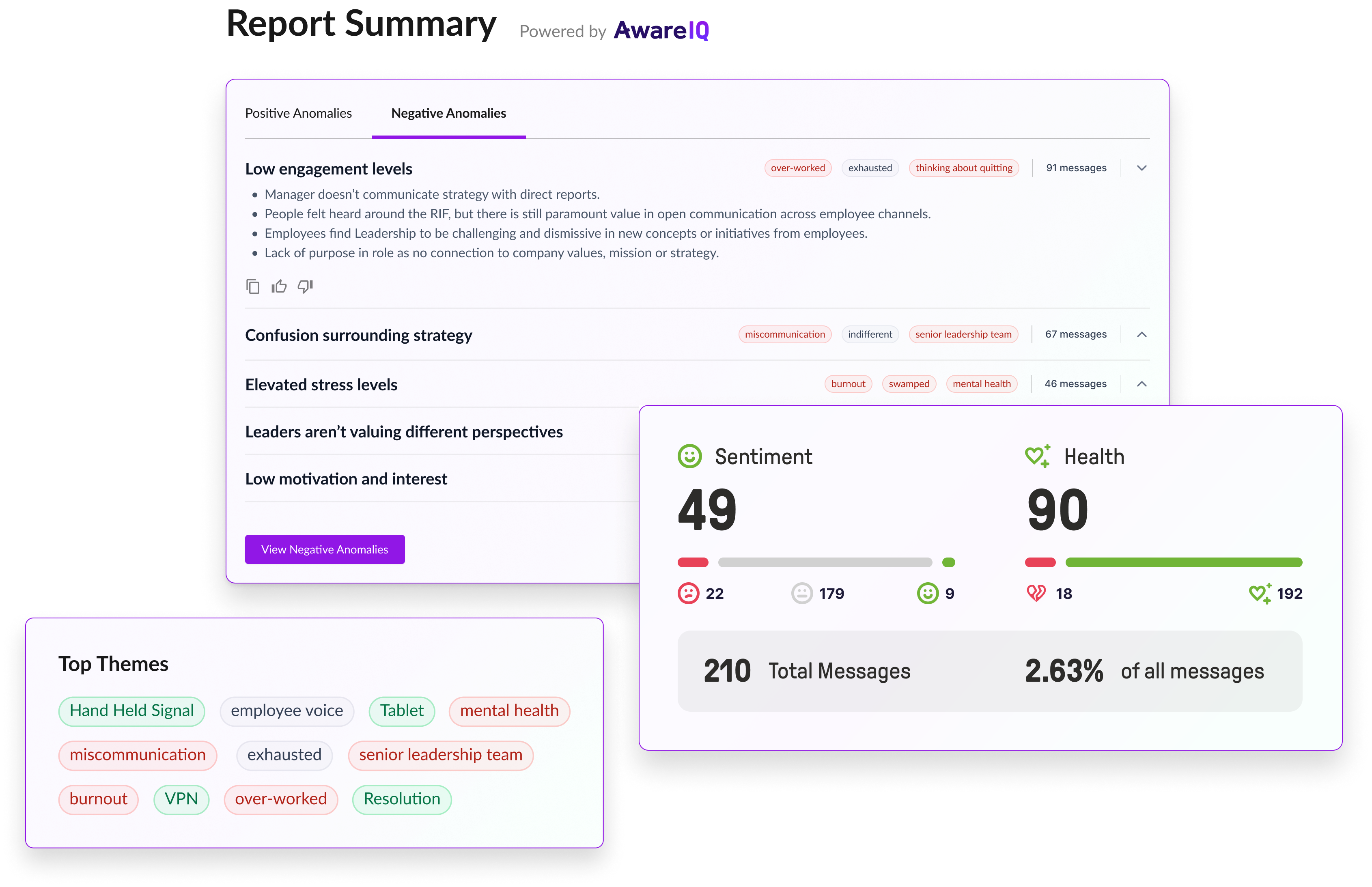
Get more from your workplace surveys with open-end analysis from Aware
Why is it important to track the voice of the employee?
Measuring the voice of the employee (VoE) offers many benefits to organization. These include:
- Increased employee engagement and job satisfaction
- Improved employee retention
- Better decision-making
- Supported diversity and inclusion
- A more positive workplace culture.
By actively listening to employees and acting on their feedback, organizations can create a more productive and fulfilling work environment that promotes employee satisfaction while gaining a competitive edge in the market.
Company Culture:
Understanding the sentiment and opinions of employees can shed light on company culture and employee experience. Positive changes based on employee feedback can lead to a healthier and more inclusive workplace that supports diversity and inclusion, in turn leading to higher employee engagement, satisfaction, and retention.
Early Issue Detection:
VoE programs can proactively detect issues and concerns in their early stages, whether that’s festering negativity and toxicity or frustrations with company policies and processes. This allows organizations to address issues in real time—before they escalate into harmful problems.
Competitive Advantage:
Companies that actively listen to their employees and take action based on their feedback often have a competitive advantage. A satisfied and engaged workforce can be a key differentiator in attracting top talent and winning customers.
Legal Compliance:
In some industries and regions, there are legal requirements for collecting and addressing employee feedback, particularly related to workplace safety, discrimination, and harassment. VoE programs help organizations stay compliant with these regulations.
Innovation and Idea Generation:
Employees often have valuable insights and innovative ideas that can benefit the organization and improve operational intelligence. The employee voice is an important source of innovation that executives can harness by capturing and implementing employee suggestions.
Employee Well-being:
Addressing employee concerns and stressors can contribute to improved mental health and overall well-being among the workforce, reducing employee burnout and improving morale.
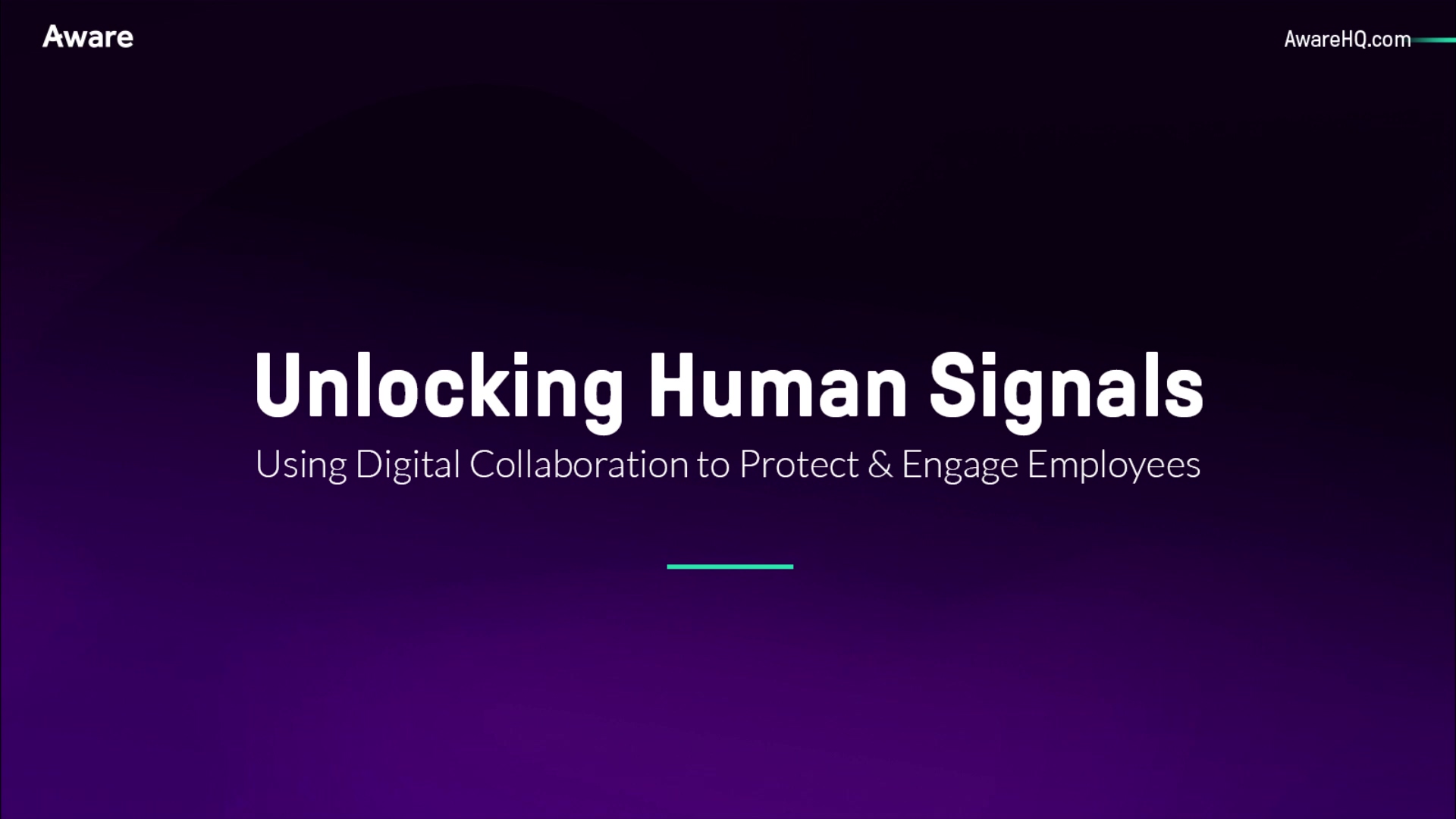
Webinar: How to drive employee engagement and satisfaction using people intelligence insights
By listening authentically to employees and actioning the insights gained from the employee voice, businesses can foster a greater sense of inclusion and value, thereby increasing employee engagement and reducing turnover. This strategy can drive higher productivity and save the costs and downtime associated with high employee churn.
Employee listening can also highlight training shortfalls. These insights can inform programs that help employees develop skills and grow in their careers. This has the added bonus of improving customer experiences, as happy, well-trained employees are more likely to know how best to support your customers and reflect their positive experiences with the company in those interactions.
Some feedback from employee listening strategies can be hard for leaders to hear, especially in organizations that struggle with culture health. However, voice of employee programs encourage open and honest communication that can help executives improve top-down messaging and understand what is going wrong within the organization, giving them a realistic chance of fixing it.

Webinar: Discover how you can unlock valuable employee listening insights from collaboration conversations
How do you capture the voice of the employee?
There are many ways that leaders can collect data on the voice of the employee. These include one-on-one interviews, focus groups, employee surveys and more. These methods provide static benchmarks by which employee sentiment and feedback can be measured over time. They are also extremely useful for understanding employee reactions to new initiatives, benefits, and changes in the company structure and leadership.
Pulse surveys can help leaders explore specific topics in detail and provide ways for employees to express themselves and deliver feedback anonymously. Focus groups and individual interviews allow the organization to engage in more interactive discussions about employee needs and drill into issues at a personal level with employees willing to engage. However, when issuing any poll or building a focus group, care must be taken to avoid biases.
Who makes the decisions what questions to ask (or not ask) in annual employee surveys? Who leads focus groups and are they capable of convincing employees they’re in a safe space to be honest? Will negative feedback in a one-to-one interview reflect poorly on the person conducting it? And how long do the results of any of these methods take to aggregate, analyze, and deliver to leadership?
These difficulties are magnified in low-trust workplaces, where honest feedback is rarely provided. Even when told that their feedback is anonymous, employees may still be uncomfortable telling the truth if they anticipate retaliation, or they may already be too checked-out to care about improving conditions at the company.
Distrust and apathy among the workforce make it futile to ask for honest feedback. To overcome these challenges, many organizations augment formal processes with passive listening in tools, apps, and platforms where people routinely communicate. These includes employee social media forums, internal social networks, and workplace messaging platforms like Slack and Microsoft Teams.
At scale, the fluctuations in group sentiment and the rise of trending topics across the business can deliver actionable insights that may go overlooked in surveys or focus groups. Unstructured data sources provide the continuous stream of insights that organizations need to get real-time, direct data from the voice of the employee.
Aware connects natively to these collaboration tools, enabling leaders to implement passive listening strategies that don’t impact the end user experience. With Aware, organizations can aggregate, analyze, and act upon employee feedback swiftly and effectively using industry-leading AI and natural language processing (NLP). Aware’s technology was designed and trained on short-form collaboration messages, providing the industry’s most accurate sentiment and topic insights.
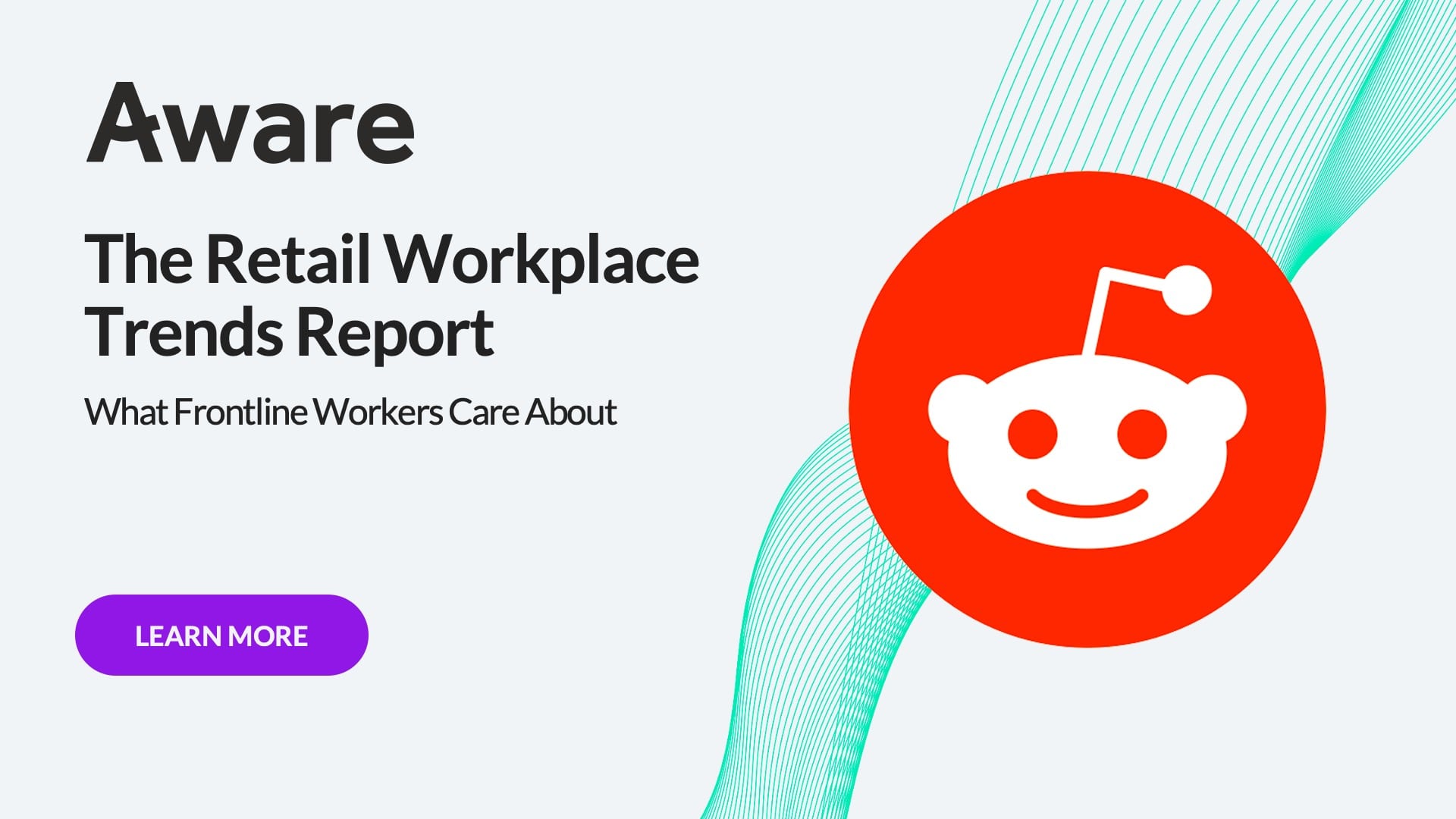
Study: What do frontline workers care about?
Best practices to improve employee listening
To get the most from any voice of employee initiative, executives should think strategically about both the implementation of employee listening measures and how the data they generate will be analyzed and acted upon. By setting clear goals, proactively minimizing bias, and curating reliable data from the right sources, leaders can ensure the insights gained from employee listening are more authentic and actionable.
- Set Clear Goals and Objectives: Ensure that voice of employee efforts align with your organization's strategic objectives and there is a clear purpose for collecting employee feedback.
- Audit Existing Programs: Review current voice of employee initiatives to identify what's working and where improvements are needed.
- Determine Data Collection Methods: Define the specific data to collect and the methods to use, considering both traditional and modern channels.
- Ask Good Questions: Craft employee engagement survey questions that are relevant, unbiased, and actionable, enabling them to deliver meaningful insights.
- Make It Continuous: Employee listening should be a cultural value embedded in the organization's DNA, not just a periodic exercise or crisis management measure.
- Use Tools for Reliable Data Collection: Consider leveraging advanced tools and technologies, like Aware's solutions, to enhance the reliability and efficiency of data collection.
Examples of voice of the employee in action
Filling the gaps between traditional employee engagement surveys
A major pharmaceutical company wanted to hear their employees’ opinions but were spending 6-8 months on each survey they issued. Using Aware, they were able to aggregate employee sentiment and trending themes from internal chat tools and gained a real-time pulse on the health of their organization.
Uncovering the root cause of high turnover
When a tech company lost a string of promising new hires, they turned to Aware to discover why. They uncovered gaps in their onboarding processes and weaknesses in their organizational culture that left new employees feeling lost and alienated. With these insights, they were able to improve their onboarding experience and fully integrate their whole team.
Re-engaging employees and defending against burnout
This global restaurant chain was looking for new ways to engage their employees, reduce burnout, and decrease turnover. They used Aware to track the success of new initiatives, address confusion during rollouts, and understand in real-time how employees felt about their efforts.
How Aware gathers the authentic voice of the employee
Aware supports employee listening initiatives with proprietary natural language processing (NLP) technology designed specifically for short-form collaboration conversations.
Unlike email, collaboration chats are filled with slang, abbreviations, and emojis. They lack the formal structure of other written content, and flow effortlessly between public, private, and direct channels with little context. Making sense of these conversations requires technology that was built for the unique complexities of this dataset.
Artificial intelligence and machine learning technology provides the computing capabilities necessary to ingest collaboration messages and analyze them in real time, giving business leaders a real-time overview of changes in the mood of the organization and surfacing issues having the greatest impact on employees. Aware’s AI/NLP data models deliver near-human sentiment analysis for the most informed, actionable people intelligence insights available today.
- Enable passive listening on all workplace communication channels
- Easily integrate with top collaboration tools like Slack, Teams, and Workplace from Meta
- Analyze open-ended survey responses in minutes, not days
- Deliver automated summaries, backed by public verbatims, to reduce manual review time
- Secure and protect employees at every step with data anonymization and role-based access
Using insights from Aware, executives can improve top-down communications by exploring timely reports on topics and sentiment surrounding campaigns and business processes, helping to resolve miscommunications in real time, while instant access to behavior insights enables data-driven decision making based on a majority consensus, not the opinions of a loud minority.
Unlocking the authentic voice of the employee has never been more important, and—thanks to the proliferation of digital collaboration tools—that voice has never been louder. Using Aware, executives can cut through the noise and understand the voice of their employees, effortlessly identifying the topics, themes, and insights having the biggest impact on the business today.
